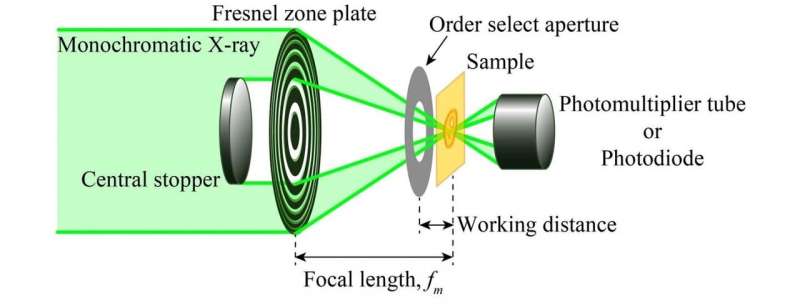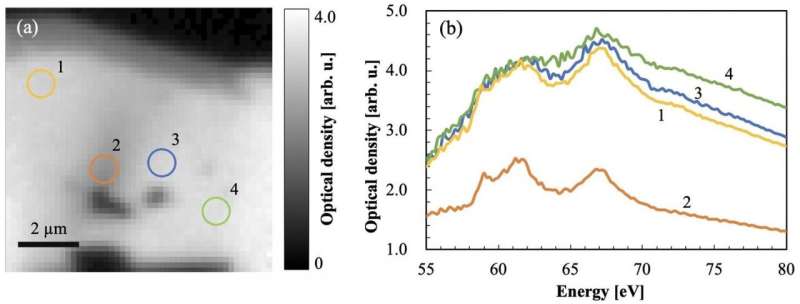Schematic of an optical system of a scanning transmission soft X-ray microscope (STXM). Credit: NINS/IMS
Lithium-ion batteries (LIB) are widely used for daily products in our life, such as hybrid cars, cell phone, etc. but their charge/discharge process is not fully understood yet. To understand the process, behaviors of lithium ion, distribution and chemical composition and state, should be revealed. A research group in the Institute for Molecular Science observed that scanning transmission X-ray microscope (STXM) can be a powerful technique to perform X-ray absorption spectroscopy (XAS) with high spatial resolution.
By using the absorption edge of a specific element, the 2-dimensional chemical state of a sample can be obtained. To analyze lithium by STXM, the Li K absorption edge (55 eV) in the low energy region makes it difficult to measure the XAS due to lack of a proper optical element and tremendous higher-order harmonics from a monochromator which contaminate XAS. Therefore, a low-pass filtering zone plate (LPFZP), a focusing optical element of the STXM, was developed to overcome these issues. The LPFZP uses silicon of 200 nm thick as a substrate of the zone plate and the substrate works as a low-pass filter above 100 eV by using Si L2,3 edges.
The hybrid optics of the LPFZP can suppress the higher-harmonics without installing an additional optical component into the STXM. As a result, the STXM with the LPFZP suppresses higher-order harmonics down to 0.1% of an original intensity and enables to measure XAS spectra of the Li K-edge. Then the spatial resolution was estimated as 72 nm.
A thin section sample of a test electrode of the LIB was analyzed. The sample is made of Li2CO3 by a focusing ion-beam process. The STXM image at 70 eV and the Li K-edge XAS spectra are shown in Fig. 2(a) and 2(b), respectively. The XAS spectra are successfully obtained from the regions indicated by circles in Fig. 2(a).
Fig. 2. (a) STXM image of a lithium carbonate sample with 70 eV soft X-ray and (b) Lithium K-edge X-ray absorption spectra at areas 1-4 indicated by circles on Panel (a) Credit: NINS/IMS
To understand the behavior of lithium in the LIB is necessary to improve its performance, at which point STXM with the LPFZP will be helpful to analyze the lithium with high spatial resolution.
More information: Takuji Ohigashi et al, A low-pass filtering Fresnel zone plate for soft x-ray microscopic analysis down to the lithium K-edge region, Review of Scientific Instruments (2020). DOI: 10.1063/5.0020956
Provided by National Institutes of Natural Sciences

























